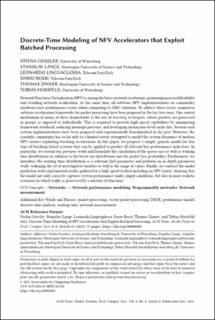| dc.description.abstract | Network Functions Virtualization (NFV) is among the latest network revolutions, promising increased flexibility and avoiding network ossification. At the same time, all-software NFV implementations on commodity hardware raise performance issues when comparing to ASIC solutions. To address these issues, numerous software acceleration frameworks for packet processing have been proposed in the last few years. One central mechanism of many of these frameworks is the use of batching techniques, where packets are processed in groups as opposed to individually. This is required to provide high-speed capabilities by minimizing framework overhead, reducing interrupt pressure, and leveraging instruction-level cache hits. Several such system implementations have been proposed and experimentally benchmarked in the past. However, the scientific community has so far only to a limited extent attempted to model the system dynamics of modern NFV routers exploiting batching acceleration. In this article, we propose a simple, generic model for this type of batching-based systems that can be applied to predict all relevant key performance indicators. In particular, we extend our previous work and formulate the calculation of the queue size as well as waiting time distributions in addition to the batch size distribution and the packet loss probability. Furthermore, we introduce the waiting time distribution as a relevant QoS parameter and perform an in-depth parameter study, widening the set of investigated variables as well as the range of values. Finally, we contrast the model prediction with experimental results gathered in a high-speed testbed including an NFV router, showing that the model not only correctly captures system performance under simple conditions, but also in more realistic scenarios in which traffic is processed by a mixture of functions. | en_US |
